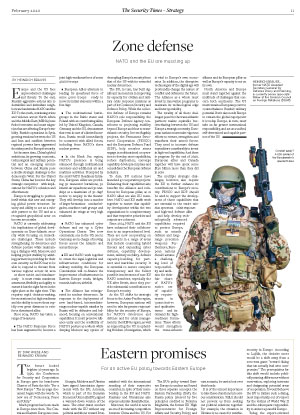For an active EU policy towards Eastern Europe
The future looked brighter 30 years ago. In 1990, the Conference for Security and Cooperation in Europe gave its brand-new Charter of Paris the title “For a New Europe.” The 30-page document began with the words: “A new era of Democracy, Peace and Unity.”
Much progress has been made in Europe since then. The Central and Eastern European countries of Poland, Slovakia, Czechia and Hungary are now equal members of the EU and NATO, and their citizens have carried out a remarkable economic and social transformation.
The results have not always been stable, however, as developments in some countries show. Above all, European unity has not been achieved. The split in the continent now lies further east.
On the other side of that border lie the states of the Eastern Partnership (EaP), which include Armenia, Azerbaijan, Georgia, Belarus, Moldova and Ukraine – but also the Russian Federation.
Georgia, Moldova and Ukraine have signed Association Agreements with the EU; Armenia, which is part of the Eurasian Economic Union (EAEU), signed a watered-down version of the same. The other states conduct trade with the EU without any political ambitions toward Brussels.
In the 30 years since 1990, people living in these countries have undergone a major transformation process. And yet, prosperity and stability are still fragile, and people are dissatisfied with the results of the transformation.
This goes for the field of international relations, as well. According to a survey conducted last year by the Vienna-based Regional Office for Cooperation and Peace in Europe (ROCPE) affiliated with the Friedrich Ebert Foundation together with the Paris-based global market research company IPSOS, citizens in Latvia and Poland are not satisfied with the international standing of their respective countries, in spite of their membership in the EU and NATO. Russians and Ukrainians also express a similar dissatisfaction.
Moreover, the world is now in an era of increasing competition between China and the US. For its part, Russia has regained military strength and is also getting involved. In other words, the EU cannot exempt itself from this field of conflict.
Even before taking office, European Commission President Ursula von der Leyen stated that she intended to lead “a geopolitical commission,” whereby the concrete political formulation of that goal is still pending. The volatility that characterizes international relations at the moment is likely to increase rather than decrease. In the meantime, the US is redefining its interests and involvement in Europe while its economic sanctions continue to impact EU countries.
The EU’s policy toward Eastern Europe is unclear and based on three separate concepts: the Eastern Partnership (EaP), the Russia policy (steered by five principles credited to Federica Mogherini, the former EU High Representative for Foreign Affairs and Security Policy) and the Central Asia strategy. The EU’s policy toward Eastern Europe will have to tie together these strands and come up with a viable strategy going forward. For example, in the future, EaP civil society projects carried out at the EU level could – depending on their relevance – include the Russian side.
European policy toward eastern neighbors is burdened by a tangible historical distrust felt by Poles, Estonians, Latvians and Lithuanians as well as Georgians and Ukrainians. They fear a potential agreement between Russia and EU countries, such as Germany and France; an agreement that would, in the worst-case scenario, be carried out over their heads.
It is of the utmost importance to take these objections into serious consideration. Still, it should not prevent us from seeking out political solutions together. For example, the situation in Ukraine is no cause for satisfaction on the part of us EU citizens.
Fifty years ago, at a time when the situation was just as muddled as it is today, Egon Bahr – a key political figure in the era of Ostpolitik – called for a policy of small steps. At that point in time, Germany’s long-term strategic goal was reconciliation with the countries of Eastern Europe and, ultimately, German reunification. For the EU today, the long-term strategic goal should be a united Europe.
In 2019, OSCE chairman and Slovak Foreign Minister Miroslav Lajčák argued that OSCE rules and regulations were entirely sufficient to ensure security in Europe. According to Lajčák, the decisive move would be a shift away from a zero-sum game “toward dialog that can actually lead us to compromise.” The prerequisites for this shift would include publically naming differences without reservation, exploring interests and designating potential areas of cooperation. It would behoove the EU to initiate such a dialog, most importantly out of respect for the victims of World War II and the subsequent responsibility to ensure a peaceful Europe.
Today, the export-oriented EU relies on a strategic foreign policy. It is in their interest to formulate a concrete policy toward Eastern Europe. After all, if the EU seeks to achieve peace and unity in Europe, it will have to act with energy and foresight.
DIRK WIESE (SPD)
is the German government’s Coordinator for Intersocietal Cooperation with Russia, Central Asia and the Eastern Partnership Countries
REINHARD KRUMM
heads up the Friedrich Ebert Foundation’s Regional Office for Cooperation and Peace in Europe (ROCPE) in Vienna.



